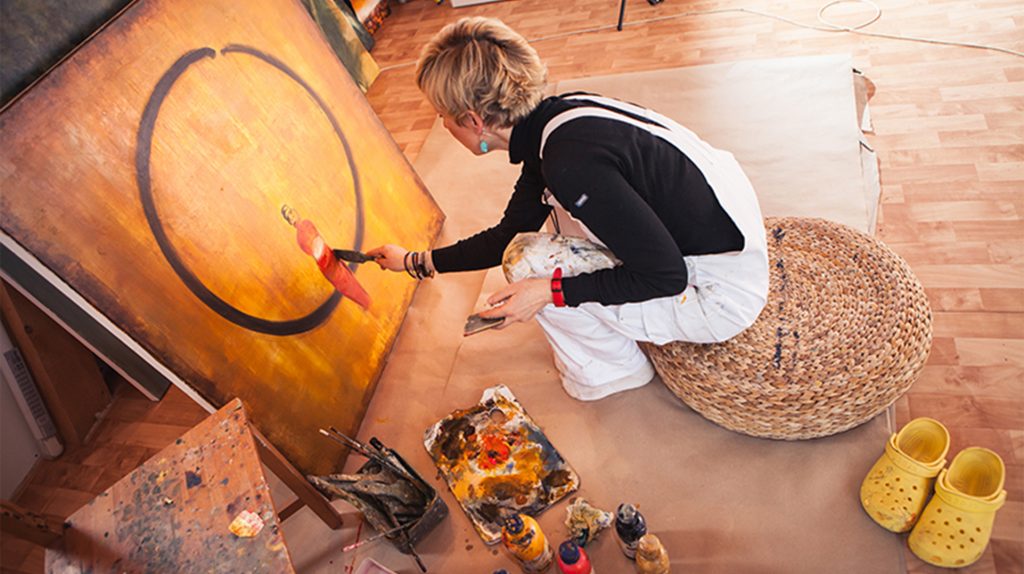The works of Sanna Myrttinen strive for a sense of interconnectedness and act as gateways to stillness and harmony in an increasingly polarized and disconnected world. The more the world seems to fall apart, the greater she finds her desire to weave and patch it together. Her meditative works speak a language that bridges Eastern philosophy with her own Nordic heritage. Spiritual growth and the search for connectedness with nature and with each other are reoccurring themes.
Biography
Having spent her early childhood in the sparsely populated region of Kajaani, Finland, Myrttinen has always felt a close connection to nature. In the winter months, she would often tag along with her mom and brother to the local weaving studio, where she would sit under the loom and draw on paper rolls from the local paper mill where her dad worked. In this way, a connection between crafts/weaving, paper and nature slowly began to emerge.
After initially completing a M.Sc in Forestry at the university of Helsinki and working in the European sawmill- and paper industry, Myrttinen finally decided to pursue her dream of studying art in 2002. Through her studies at Växjö University (now Linnaeus University) and the university’s close ties to Japan, she was able to access the university’s invaluable books on classical Japanese art. In search of her own visual language, these books seemed like a refreshing change from the European styles and -isms. It was the tranquility, the emphasis on emptiness and the aesthetic concepts of Eastern philosophies that deeply resonated with her and began to form her artistic path.
Extensive travels to South East Asia, a keen interest in the ancient Chinese teachings of Feng Shui, as well as in Taoism and Zen Buddhism, further influenced her style and use of color. Her motifs, colors and compositions started to carefully align with these teachings and philosophies.
An introduction to the fine art of Hitsuzendo (Japanese Zen Calligraphy) with the zen monk Dokko-An Kokugyo Kuwahara, was another stepping stone for Myrttinen to begin exploring the highly meditative and challenging art of ink painting. Inspired by the ink works of Japanese artist Joshio Ikezaki, Myrttinen began to develop her own style, moving from oil and acrylic landscapes to increasingly minimalistic ink works depicting imaginary landscapes bringing together her Nordic roots with her current Alpine life.
In the past few years, she has also challenged herself in embracing new media and techniques. Again going back to her roots, she has experimented with weaving with paper, as well as with the ancient art of mosaicing, knot making and interlacing. By combining these traditional forms of handicraft, Myrttinen has not only created her own interdisciplinary form of expression, but also showcased how seemingly opposing materials such as paper, glass and yarn can form ways of interconnecting.
When not painting or experimenting with interdisciplinary projects, Myrttinen enjoys working on her book series “The Adventures of Feliz”. It is her first series that she is both writing and illustrating.
Sanna Myrttinen is a member of the German BBK (Bundesverband Bildender Künstlerinnen und Künstler e.V.), the German Professional Association of Visual Artists. Her studio lies on a farm above lake Starnberg, amidst the beautiful, hilly Bavarian countryside. She spends her free-time climbing, hiking, skiing and kayaking with her partner and Phoebe, their Basset Griffon B. She is also an active member of the environmental organisation Fans For Nature (www.ffn.org) and has been continuously supporting their projects to preserve the last remaining orangutans since 2008.

Statement
Sanna Myrttinen regards painting and mosaicing as an active form of meditation, whereby her works act as gateways to stillness and peace in an increasingly disharmonious world. She believes that by becoming still, by re-connecting with ourself and with nature, we come to sense a new kind of interconnectedness and appreciation with our social, cultural and natural environment.
Her meditative landscapes and simplified, playful forms with emphasized outlines, speak a language that bridges Eastern philosophy with her own Nordic heritage. Spiritual growth and the search for connectedness with nature and with each other are reoccurring themes.
The works range from vibrant mixed media paintings with contemplative texts to playfully scraped cityscapes and reinterpreted maps reminiscent of South-East Asian landscape paintings and woodcuts. Her meditative works follow in the tradition of Enigmatic Realism and are inspired by the aesthetic concepts of Eastern philosophies.
